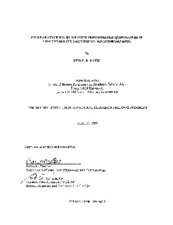| dc.description.abstract | Widely considered in the medical field as the last of the golden anti-microbial drugs, fluorinated quinolones provide a "last defense" for the attack on bacterial infections. The drugs are useful for treating gram negative and some gram positive infections. Among the advantages of fluorinated quinolones are oral dosing, resistance that develops slowly via mutation rather than plasmid mediated mutations and high bactericidal activity at low concentrations. All are quinolone carboxylic acid derivatives, which inhibit bacterial DNA gyrase, a mechanism of action unique among the antibacterials. The drugs considered in this study were enrofloxacin, ciprofloxacin, difloxacin, and orbifloxacin. Enrofloxacin, difloxacin, and orbifloxacin are veterinary products used to treat dermal, respiratory and urinary infections in small animals. Ciprofioxacin, however, is a human drug used for similar infections. The human drug, ciprofloxacin, is often cited as effective against selected microorganisms in veterinary medicine, while the veterinary drug, enrofloxacin, is cited as resistant. As a result, veterinarians often use the human drug. Yet, the chemical structures of the drugs suggest that microorganisms should exhibit similar susceptibility patterns. This study hopes to prove an equal effectiveness of enrofloxacin and ciprofloxacin. Microbial susceptibility to drugs is measured by determining the MIC (Minimum Inhibitory Concentration). The MIC is measured based on the growth of the targeted bacteria in increasing concentrations of each drug following incubation under standard conditions. A method using microtiter plates containing broth was developed to measure concentrations of growth using colorimetric procedures. Comparisons in 100 bacterial organisms reveal subtle differences in the MIC's between the drugs (based on micromolar concentrations) showing relative effectiveness between the organisms. This study supports our belief that bacterial susceptibility does not differ among enrofloxacin and ciprofloxacin available to the veterinary practitioner. This study also attempts to explain mechanisms of resistance in microorganisms found to be resistant to the four fluorinated quinolones. Using biochemical techniques, these organisms will then be used to analyze patterns of resistance on a cellular level with determination of why the organism is resistant. Searching for patterns of resistance involves isolating the DNA, PCR reactions for amplification of the DNA, and bacterial transformation. | en |


